Your cart is currently empty!
Top 10 EMF Radiation Myths Debunked

‘Your phone will give you cancer’ was a common dialogue surrounding cell phones when they first entered the market decades ago. Top 10 EMF Radiation Myths Debunked
As cell phone technology got better and more convenient, people saw how beneficial cell phones and other mobile devices were. Losing those benefits became unimaginable. The Telecom Industry funded research claiming these devices presented no ill effects, and any potential health concerns were brushed under the rug.
Until now. The discussion around EMF radiation from mobile devices and cell phone towers has gotten a reboot following the deployment of the latest cellular network, 5G, along with our constant contact with our digital devices 24/7.
5G will ensure that everyone and everything can be connected at all times, with a faster, more powerful signal. It will become increasingly difficult to avoid these wireless transmissions, which has sparked a discussion as more and more people feel like their safety might be compromised. Anti-5G groups are fighting local governments and the FCC, as 5G gets implemented in the U.S. and worldwide.
Like other trending discussions in the socioeconomic and political spheres, EMF radiation is a hard-to-understand topic with many nuances, and is overrun with so-called ‘experts’ that don’t have much knowledge besides what the Internet has provided them. While the Internet does have TONS of very valuable, factual information, its vast data archives and anonymous sources create even more confusion and controversy. Many times, it is difficult to analyze the good sources of information and even harder to put them into context.
Here, we clear up the 10 most common misconceptions surrounding EMF radiation and safety.
Top 10 Misconceptions About EMF Radiation
1) EMF Research is Inconclusive Which Means EMFs Can’t be Harmful
1) EMF Research is Inconclusive, Which Means EMFs Can’t be Harmful
Many governmental and scientific bodies have maintained that research currently does not show that EMF radiation is harmful to the average person. Many scientists and researchers agree that the current research is inconclusive, and this makes many people wrongly assume that EMF cannot be harmful to us.
EMF research is simply not advanced enough to prove without a shadow of a doubt that EMF radiation is harmful to the average person. That DOESN’T mean the research doesn’t exist, or that we shouldn’t be worried.
Many scientists and researchers acknowledge that there is cause for concern, and that much more research is needed to establish an informed stance on the issue.
While we agree that much more research is needed, especially dealing with our current extensive use of mobile devices and smart technology, heaps of studies already exist showing effects of EMF radiation—over 800 scientific studies, in fact.
A majority of this research shows positive associations between EMF radiation and adverse biological effects, with a couple notable publications finding evidence of causal effects.
So why do some say the research is inconclusive? A couple reasons. First and foremost, there are other studies that show there are no significant harmful effects. It is interesting to note that most of the conflicting research is funded by the cell phone industry, and independent scientists, such as Dr. Martin Pall, have found this research to be biased, or designed to fail.
For example, Jeffry Fawcett, PhD found that ‘of industry funded studies, only 27% found an RFR (Radio Frequency Radiation) effect. Independently funded studies found an RFR effect 68% of the time. This discrepancy is consistent among the effects listed.’
It may be true that telecom companies don’t want evidence showing their devices are harmful because that would negatively impact the company’s image and affect product sales.
Of the research showing effects from EMF exposure, some research study populations are not large enough to establish statistically significant effects. Additionally, it is hard to prove a biomechanism responsible for the biological effects, but there are many theories—one developed by Dr. Pall—that are being looked into. Even so, the data still shows effects are present and more research is needed to find consistency and the biomechanics responsible.
After reviewing the research, the World Health Organization (WHO) – International Agency for Research on Cancer (IARC) has classified EMF radiation as ‘possibly carcinogenic to humans‘, which means that more research on humans is needed to show it as a probable carcinogen.
The World Health Organization writes that the technology is too recent to rule out possible long-term effects. Even so, the organization acknowledges that scientific evidence about the health effects of EMF is substantial, with health outcomes ranging from reproductive defects to cardiovascular and neurodegenerative diseases, and even childhood leukemia.
EMF scientific research is growing, especially now that the effects of 5G need to be studied. Further research on long term exposure should be conducted, but enough preliminary evidence proves we should be concerned and at least take precautionary steps.
We will talk more about studies later on.
2) Non-Ionizing EMF Radiation Isn’t Harmful
2) Non-Ionizing EMF Radiation Isn’t Harmful
There are two types of radiation: ionizing and non-ionizing.
Ionizing Radiation removes electrons from atoms and molecules of materials that include air, water, and most important to your health, living tissue. Ionizing radiation is damaging to the body because it instantly splits molecules and ionizes the electron of the atoms.
Non-ionizing Radiation does not have enough energy to remove electrons and break bonds. This type of radiation is on the lower end of the Electromagnetic Spectrum and is abundant in the radio frequencies used in our modern technology. Many argue that since EMF is non-ionizing, there’s no way it can harm us.
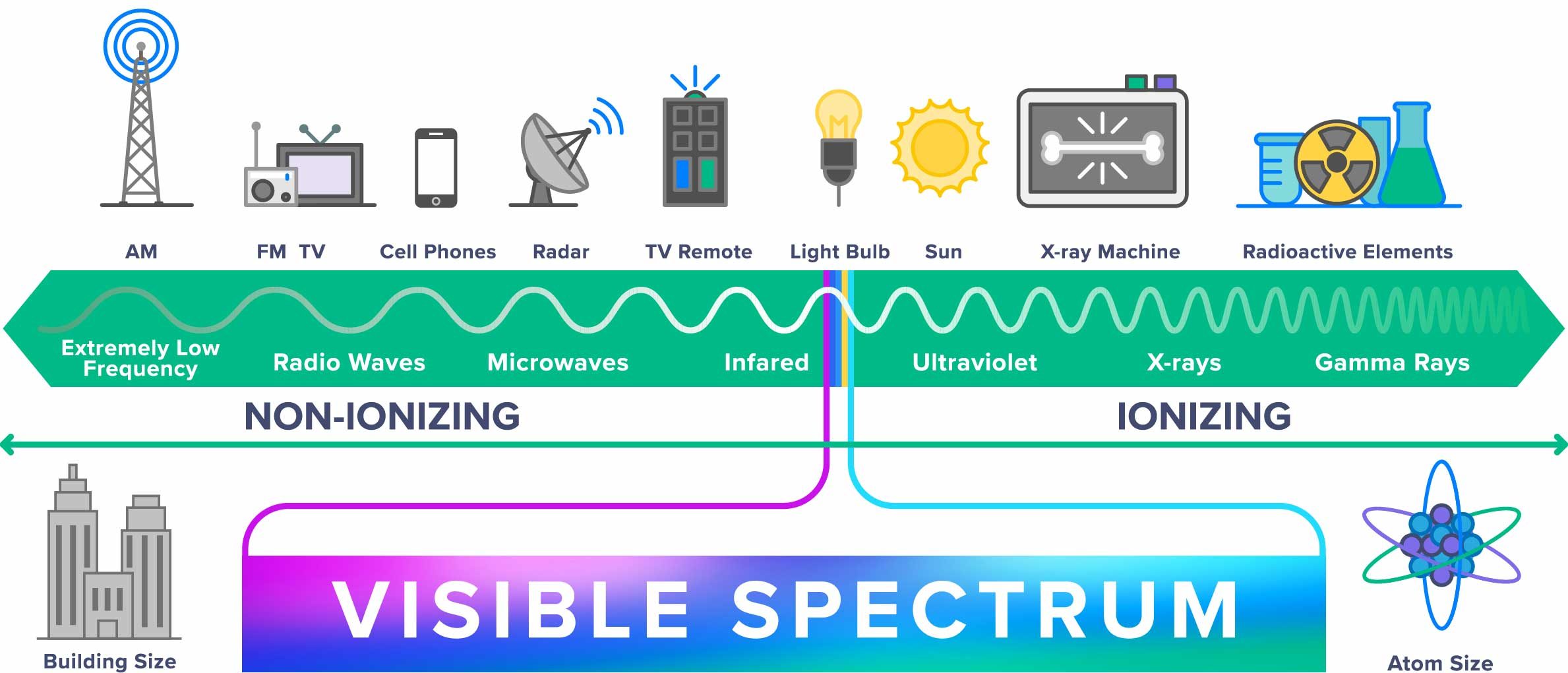
For a long time, the scientific community believed that lower level energy radiation could only cause damage to your body from the thermal effect of the energy frequencies, meaning damage could only occur when there was enough low-energy radiation present to heat up cells and tissues to the point of damage. It wasn’t thought that radiation of a low, non-ionizing level could cause harm to the body if there wasn’t heat present.
We now know non-ionizing radiation can ALSO cause biological damage.
While non-ionizing radiation can indeed cause thermal damage when cells are heated, new research has established non-ionizing radiation causes biological change within cells, regardless of heat being present. Studies have shown that EMF-level frequencies can induce oxidative stress, create a cell danger response, and activate the voltage gated calcium channels (VGCC) in your cells, which can disrupt entire processes in your body and lead to a range of health problems—fertility problems (which can also be caused by thermal damage), cancer, neurological disease, and endocrine issues.
Non-ionizing radiation may not have the same initial impact as ionizing radiation, since most of us have resilience in our cells. But over time, the small effects can add up and chronic exposure can lead to serious health problems.
3) Government Phone Radiation Standards Ensure All Phone Emissions Are Safe
3) Government Phone Radiation Standards Ensure All Phone Emissions Are Safe
Cell phone radiation standards exist to protect people from too much exposure, but they might be creating a sense of false safety, since many countries use standards that are outdated, incorrect, and that are not followed by cell phone manufacturers.
The FCC standard, called the SAR (Standard Absorption Rate) Standard, hasn’t been updated since 1996. The iPhone was still a decade away from being invented at that time, and the iconic Nokia 3310 wouldn’t be introduced for six more years. In 1996, only 16% of Americans had a cell phone. The latest data from Pew Research Center shows that 96% of Americans now have a cell phone, and 81% have a smartphone. Of these, many are young children.
The FCC states that the limit for public exposure from mobile cell phones is a SAR level of 1.6 watts per kilogram. Below are a few reasons this limit is outdated:
- The FCC made this standard back when they were only trying to protect from the thermal cell damage (stated above in Myth #2). The SAR level only protects from excessive heat levels, and doesn’t address biological damage that can still happen at lower power levels.
- To create this standard, the FCC created a 200-pound, 6-foot male testing dummy, which represents approximately 3% of the population. EMF radiation is much more harmful to developing children, pregnant women, those with illnesses or compromised immune systems, and the senior population.
- While that level of exposure might have been generally acceptable in 1996, it hasn’t been updated to take into account our modern lifestyle, where our phones are pressed against our bodies all day and lying next to (or under) our heads all night. Device ownership, usage, and consumption habits have drastically changed in the last few decades. RescueTime, an app that monitors phone usage, found that of 11,000 users, the average person spent 3 hours and 15 minutes per day on their phone, and 20% of users exceeded 4.5 hours. In addition to our lengthened exposure, phones didn’t have all the extra processors coming from WiFi and Bluetooth, or a powerful cellular connection back in 1996.
Even with this outdated safety standard, cell phone manufacturers don’t seem to be following it very well. They self-test and self-report their own phones’ SAR values. Most of the time, their results and very specific procedures for testing cannot be replicated in independent lab testing.
The Chicago Tribune did its own lab testing on cell phones they bought off the shelves, and found that Radio Frequency radiation exposure from the iPhone 7 measured over the legal safety limit and more than double what Apple has reported to federal regulators. Other popular models, like the iPhone X, iPhone 8, Samsung Galaxy S9, Galaxy S8, and the Moto E5 Play, all tested over the legal limit, too. Recently, an additional independent test done by the same California-based lab, RF Exposure Lab, found that the iPhone 11 Pro has SAR levels measuring at 3.8 W/kg.
The results of the Tribune’s test and the subsequent outcry from the public prompted the FCC to conduct its own testing. A couple months later, the FCC said they lab-tested phone models provided directly to them from the manufacturers, and all the results showed the phones were in the clear, emitting less than the legal limit of 1.6 W/kg. This information begs two questions:
- Why are the independent lab tests coming back with different results than a federal regulatory agency (an agency which has been said to be corrupt)?
- Why are the FCC-tested phones supplied from the manufacturer instead of taken off the shelf?
Regardless of if the phones actually meet the standards or not, the standards are still outdated. Devra Davis, President of the Environmental Health Trust, has filed a lawsuit against the FCC, suing it for not updating cellular phone and wireless Radio Frequency radiation limits.
‘The FCC has for years failed to protect public health by relying on 24 year-old safety tests designed when phones were the size of a shoe and used by few,’ Davis said. ‘We filed this appeal in order to insist that the agency take full measure of the U.S. government and other scientific evidence that cell phone radiation can be harmful.’
Robert F. Kennedy, Jr.’s Children’s Health Defense submitted their case against the US government for failing to protect its citizens given the FCC’s refusal to review their 25-year-old guidelines. The CHD’s Petition for Review contends the agency’s actions are capricious, arbitrary, not evidence-based and an abuse of discretion. The Petition was filed on February 2, 2020 in the U.S. Court of Appeals for the Ninth Circuit.
4) If Cell Phones Are Really That Dangerous, They Would Be Banned
4) If Cell Phones Are Really That Dangerous, They Would Be Banned
Many people assume that because cell phones are so widespread, they must be safe to use. If they weren’t safe, it seems very logical to assume cell phones and other mobile devices would be banned from production.
Unfortunately, that logic is not always followed by the government. As we know from many other past and current events, the government isn’t always proactive in thinking about peoples’ health and safety, or the health and safety of the planet for that matter.
Take the cigarette industry, for example. Why did it take so long to get regulated? Science knew for a long time cigarettes were harmful, but they still aren’t banned. Same goes for off-shore drilling and other environmentally harmful activities. They are still allowed because these industries would cost money to regulate, and the industry profits are high.
Ukiah Daily Journal Columnist Crispin Hollinshead said it best: ‘The scientific quest can become compromised when science intersects with society’s economics and politics… The world has been rapidly and profoundly transformed by cell phones, and more recently, smartphones, and there is social and economic incentive to keep finding them ‘safe’ as we move toward a more wired world. This economic bias makes rigorous scientific investigation difficult and unpopular.”
Scientist Alfonso Balmori said something similar back in 2005, when he published a study on EMF effects on storks. “Controversy is frequent when scientists recognize serious effects on health and on the environment that cause high economic losses.”
Technology is one of the biggest players in the economy and politics, and phone companies are considered the ‘pet industry’ of the FCC. Basically, the FCC is light on regulations because the phone companies influence them.
Why can’t the phone companies simply include protection? Well, that would be hard to do without reducing the functionality of your phone, and it would mean admitting to the public that there are dangers to cell phone radiation (which they already admit to in the fine print, by the way).
Just as there is a Surgeon General warning on cigarette cartons, in most phone manuals there is a statement on RF radiation in the legal terms and conditions. Apple’s statement is as follows: ‘To reduce exposure to RF energy, use a hands-free option, such as the built-in speakerphone, the supplied headphones, or other similar accessories.’
When more of the public demands change in mobile device regulations, improvements might eventually come.
5) EMF Radiation Can’t Cause Cancer
5) EMF Radiation Can’t Cause Cancer
The United States National Institute of Health (NIH) has found “clear evidence” in animal studies that RF radiation causes cancer.
Cancer is an abnormal growth of cells within the body, which leads to a range of problems. EMF studies have consistently shown that exposure to radiation causes gene mutation and DNA fragmentation—both of which can cause cell mutation and cancer.
A landmark National Toxicology Program (NTA) study under the NIH concluded in November 2018 that high exposure to radio frequency radiation was associated with: clear evidence of tumors in the hearts of male rats, some evidence of tumors in the brains of male rats, and some evidence of tumors in the adrenal glands of male rats.
Many tried to downplay these results, because A) it tested rats, B) it tested lower 2G and 3G frequencies, and C) because the whole body exposure levels were “much higher” than normal human wireless frequency exposure. But all these claims were made with no context, and thus hold no weight.
Rats are used across the board in professional scientific research since their anatomy is very much comparable to humans. Every chemical known to cause cancer in humans is also carcinogenic in rats.
The lower frequencies might have different effects, but research up to this point has not demonstrated that the body reacts differently to different RF-level frequencies. If there are different effects, it is not necessarily better or worse. Regardless, this study still proves that biological effects can happen with ‘non-ionizing radiation,’ so there is cause for concern that higher RF frequencies might be just as bad.
In terms of the rats experiencing higher exposures, the levels in the study were similar to or only slightly higher than the FCC’s limit for maximum exposure to localized tissue, since body tissues located nearest to the cell phone antenna receive much higher exposures than other parts of the body. NTP scientists agree that there is cause for concern surrounding EMF radiation, and cancer is a potential outcome.
Since then, scientists at the National Toxicology Program have recommended that people reduce the time they spend on cell phones or use the speaker or a headset. According to Microwave News, two government scientists involved in studying links between cell phones and cancer confirmed that they are following the precautionary steps.
Another study from Yale found there may be a link between cell phone use and thyroid cancer. The team analysed more than 900 people living in Connecticut, of which 440 had thyroid cancer. An analysis of 176 genes linked 10 mutations to the disease, but only in cell phone users who were genetically at-risk. This means that EMF may very well be a trigger for causing cancer in at-risk populations.
Scientist Dr. Martin Blank explains that we simply need more time in establishing a more concrete relationship between EMF radiation and cancer. “The industry is spending gazillions pointing out that there is no irrefutable proof between EMF exposures, particularly cell phone radiation, and cancer. Fortunately for them, they’ve got time on their side because of something called ‘latency period’. Cancers do not form overnight.’ In almost all cases cancerous tumors take many years to form and metastasize.
Even so, cancer should not be the only concern we have regarding exposure to EMF radiation, since many other health effects are evident that can impact our daily living.
6) 5G is Not Dangerous and Safer than 4G
6) 5G is Not Dangerous and Safer than 4G
5G is the next generation of wireless technology. The 5G network rollout began widely in 2019, and is set to pick up pace in 2020, with the goal of worldwide adoption by 2025. The spectrum in the United States has been set from 6 GHz to 300 GHz, but carriers can only purchase frequency bands up to 100 GHz.
5G builds upon the previous 4G network that went up to around 2-3 GHz. It has a higher bandwidth for practically zero latency, a massive increase in data traffic, increased peak upload rates, and a larger available spectrum.
With the shorter wavelength of the higher frequencies, one 5G base station can support over 1,000 more devices per meter than 4G. A downside of using this level of frequency is that there needs to be many more antennas to accommodate the network. Rather than the current cell towers being miles apart, small cell site 5G towers will need to be located as close to each other as every 750 feet.
Many people think that 5G will be less harmful to our bodies than 4G because the shorter wavelength cannot penetrate our skin as deeply. 5G also cannot travel as far, so the power level of these shorter wavelengths might be less than 4G. However, 5G uses different technologies. The coverage is beam-based in 5G, not cell based.
This means that 5G uses Massive MIMO (Multiple Input Multiple Output) which expands beyond current networks by adding multiple antennas to the base station. The increase in antennas helps focus energy using digital or 3D beamforming. Basically, the antennas can create focused horizontal and vertical beams directly towards a user, instead of the old method of one antenna sending out a broadcasted omnidirectional signal. While this increases data rates, data capacity, and lessens interference, this focused energy might increase your EMF exposure when you are using your device.
In addition, the increased number of cell towers needed to support this network will definitely mean more exposure to our bodies. And with 5G frequencies still able to penetrate the skin, there is still the concern of cell damage (particularly through oxidative stress) to our biggest organ that can further affect different systems in our body.
Dr. Martin Pall believes that 5G specifically will have massive impacts on the outer one to two inches of our bodies. While you might not think this is worse than 4G, 5G could activate VGCCs (Voltage-gated Calcium Channels) in your cells much more frequently. The shorter wavelength’s rapid absorption into the body and its rapid pulsations that are more biologically active may create many different biological effects.
Pall predicts blindness, hearing loss, skin cancers, male infertility, autoimmune diseases, and thyroid issues.
Israeli scientists report that higher 5G frequencies actually resonate more with human sweat ducts, which can send these signals more effectively into the body. We don’t know for sure how much these higher frequencies will affect our bodies, but even with 5G present, 4G frequencies will still be very much in use. (read more in our next Myth).
7) I’m Already Using 5G…
7) I’m Already Using 5G…
A. With My Phone
5G is here—what does that really mean? 5G stands for ‘fifth generation’ and does not actually refer to the frequencies being used. It more so describes the network evolving to bring in new, higher frequencies to its existing wireless spectrum.
Many cell phone companies have been advertising 5G nationwide coverage, but that comes with a couple of qualifications.
First, nationwide really just means they have 5G base stations set up in many different locations around the country. Chances are, unless you live in a big city or metropolitan area where your carrier has deployed 5G, you are not getting access to these 5G signals.
Second, even if you have 5G available in your specific city, that doesn’t mean your phone and devices are automatically connecting to and using it. Your device must be equipped with a 5G antenna to connect to the 5G network, and only a few phones on the market have that capability.
Even then, if you are on the 5G network, that doesn’t mean your phone is using the high-frequency millimeter (MMwave) 5G bands.
As mentioned earlier, 5G frequencies actually build on top of the 3G and 4G frequencies your phone has antennas for, meaning it isn’t a completely separate service. 5G frequencies are split up into 3 groups. The Low-Band frequencies are below 1 GHz. Mid-Band frequencies go up to 6 GHz, and the High-Band goes all the way up to 100 GHz. The High-Band group is the only one using new frequencies, including the Millimeter Wave (MMW), and they are not really being used. Even if they are, you probably aren’t receiving them unless you are VERY close to a 5G base station.
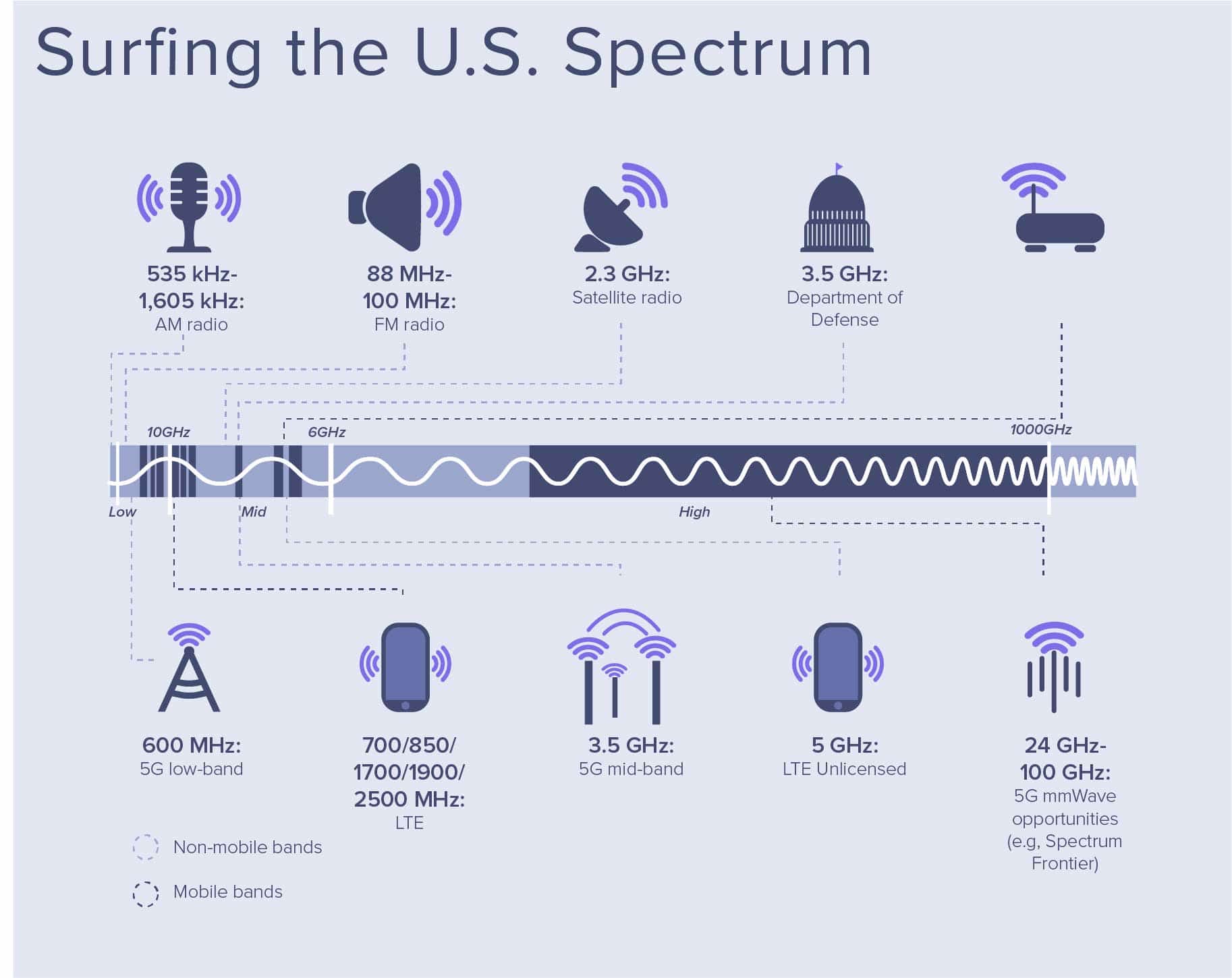
This map from Ookla, updated weekly, shows where 5G service is commercially available and where there is limited availability. You can also see what carrier deployed the service. T-Mobile has widespread service, but it uses a very low 600 MHz band (1000 MHz = 1 GHz).
6 GHz bands and above might be present in crowded public spaces and urban cities, but others might not see these higher bands for a LONG time.
B. With My WiFi Router
Let’s clear up the confusion about 5G and WiFi. WiFi routers work on two different frequencies: 2.3 GHz and 5 GHz. The 5 GHz band used for WiFi IS NOT the same as the 5G network, which uses various frequencies stated above.
5G is being implemented by the telecom companies, while WiFi routers are serviced by cable companies. Many service providers, like Verizon, promote a bundle package with phone, TV, and Internet (WiFi). But just because the company offers all three does not necessarily mean they run on the same network.
However, there is a new service called 5G Fixed Wireless offered by service providers like Verizon. With traditional wireless Internet, your router plugs into your Ethernet box in the wall of your house, which comes from your cable company via a long cable (wired). Your router than emits a wireless signal so you can connect to the Internet without having to wire in each device. With fixed wireless, a fixed antenna is installed on your house, which can then give you access to the 5G network by connecting your router or device (like a smart TV) to a wireless cell tower.
It’s easy to get confused with how 5G works with our current technology. Unless you have purchased a device designated as 5G-enabled, it will not use the 5G network. Furthermore, WiFi routers do not use the 5G network at all, so there is no such thing as a 5G router. In fact, 5G might make WiFi routers unnecessary in the future, which we discuss in our Future of WiFi article.
8) Bluetooth Earbuds are at Too Low a Power Level to Cause Any Health Damage

Many cell phone companies began removing headphone jacks in 2016 (looking at you, Apple), and as a result, Bluetooth headphones became ubiquitous overnight.
Your device sends and receives signals from Bluetooth headphones over the 2.4 GHz frequency band, the same frequency used by some WiFi routers. This wireless communication allows you to listen to audio and make phone calls hands-free.
Bluetooth headphones are battery-powered. The headphones themselves are small, and thus they have a small battery. These devices are low power-emitting compared to other devices such as WiFi routers.
Research has not shown if our bodies can tell the difference between low levels of non-ionizing radiation, so it’s probable that it can affect our bodies. Using Bluetooth headphones, however, is better than putting a powerful cell phone directly to your head.
Because AirPods don’t have a cord that connects the two earbuds to each other (like the Powerbeats Wireless by Dre for example), they have to send a signal to each other to stay synced. This signal goes directly through your head. The placement of AirPods and the length of contact—often long periods of time (sometimes all day)—increases EMF radiation to the head. Even at a low power level, the radiation goes through very important tissue and cells.
Though there isn’t research on the health effects of AirPods since they are still a relatively new technology, experts in the scientific field are trying to bring awareness to their health hazards. In 2019, more than 250 scientists signed a petition calling the International Public Health Organization to create stronger guidelines on wireless devices.
As convenient as they are, the health dangers of wireless headphones are not worth it.
9) EMF Shielding Doesn’t Work
9) EMF Shielding Doesn’t Work
We can’t speak to other brands’ EMF shields that aren’t scientifically tested. Nor can we speak about stickers, pendants, and stones that do not have a scientific basis (we will say that different types of elements are not able to block radiation, but they might be able to lessen its effect on your body if their benefits were able to be directly measured).
However, our shielding is scientifically engineered by a telecom engineer with 30 years of experience to block EMF radiation from 0-10 GHz. By having multiple layers of various alloy metals, our products absorb, conduct, and dissipate radiation for maximum blocking efficiency.
Our technology has been independently tested by an FCC-certified laboratory. The results of those tests found that our shielding blocks up to 99.9% of radio frequency radiation and 98.25% of extremely low frequency radiation. It blocks cellular, WiFi, and Bluetooth radiation.
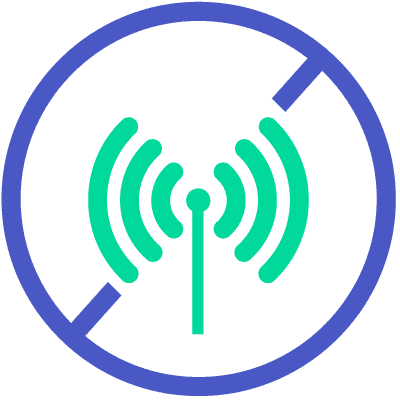
99.9% – RF Radiation
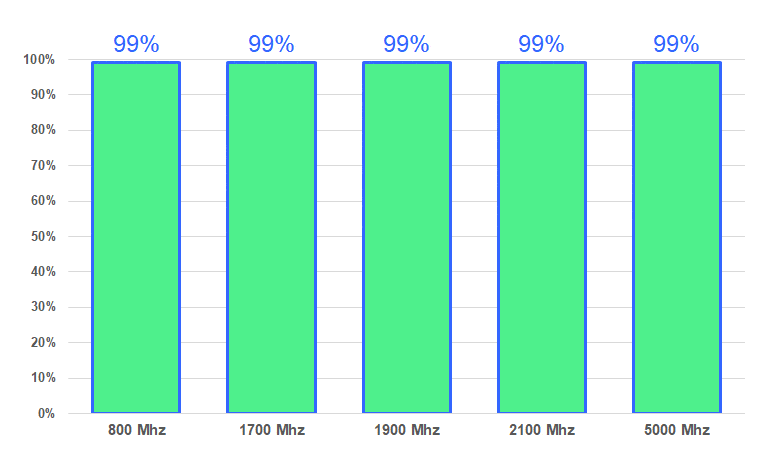
Percentage (%) blocked per frequency in MHz
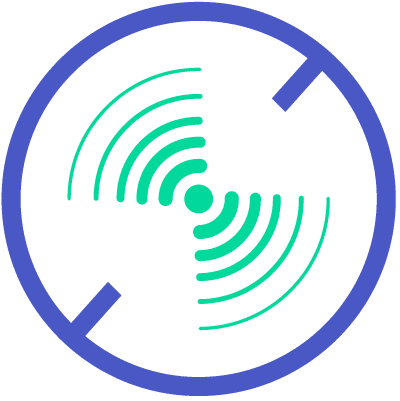
98.25% – ELF Radiation
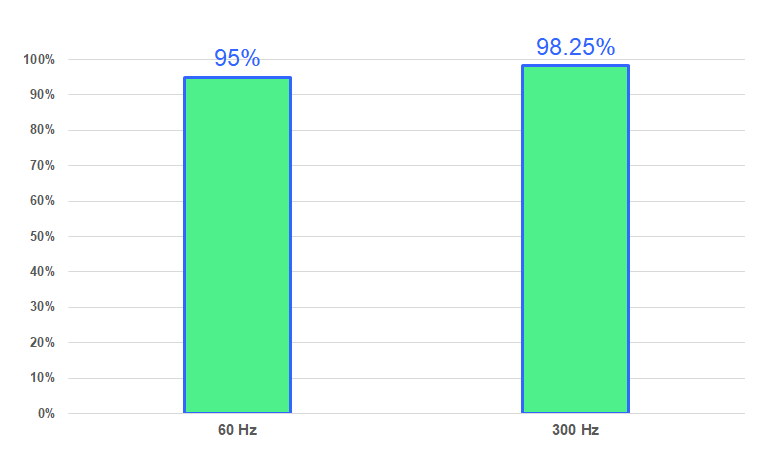
Percentage (%) blocked per frequency in Hz
A. It Actually Amplifies Exposure and Can’t Block All Signals
The shielding used in our products has been engineered as a resistive path, meaning it acts more as a net than as a vacuum. In this way, our shielding doesn’t amplify or reflect EMF radiation. Instead, it absorbs, conducts, and dissipates EMF radiation as harmless heat.
It is impossible to block radiation from your device completely, if you want to be connected to a cell tower or WiFi. Having a fully shielded and contained device would be ideal, we agree, but without the ability of the device to send and receive any signals, you would simply lose all functionality of your phone. Our front-shielded phone cases give you the protection you need, while still allowing for the transmission of the required cellular (and WiFi/Bluetooth) signals.
With one side of your device shielded, you can reduce direct contact with EMFs while still being connected, without making the phone artificially increase its power level. When you put your phone to your head to make a call, the one-sided shielding blocks the EMFs from reaching your head, but still allows the signals to be sent away from the phone to easily connect to a cell tower. Think of it as a room filled with surround-sound speakers. If you block one side, you will still easily be able to hear from the other speakers (or cell towers) without having to strain at all.
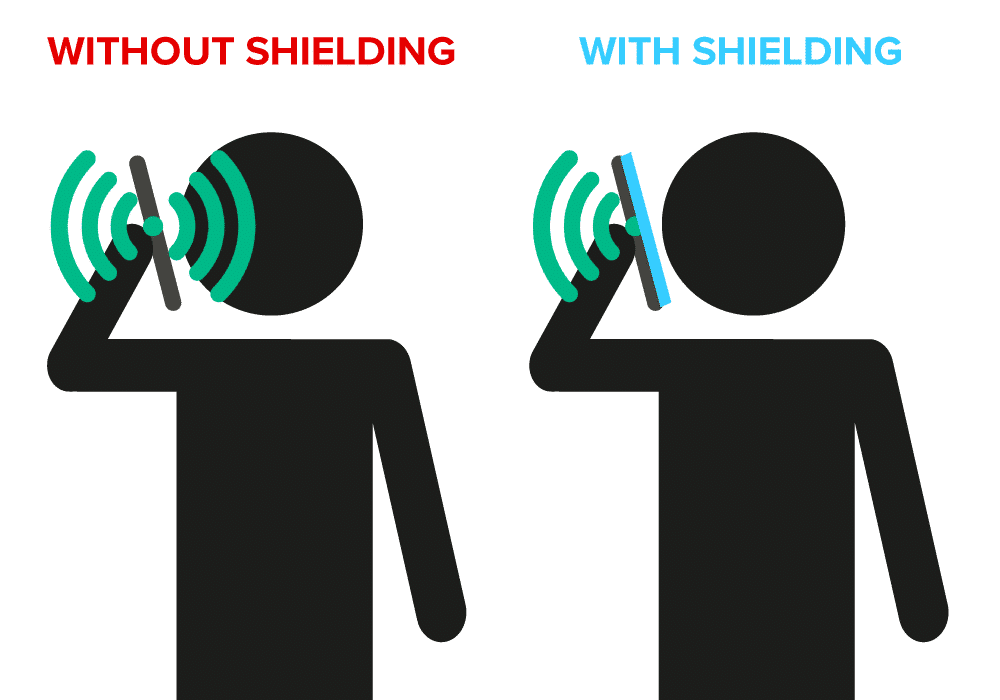
B. Because My EMF Meter Says So
FCC-certified independent labs have highly accurate and specific RF and ELF testing equipment. The lab environments are highly controlled, with all receivers and transmitters known. It is necessary to use this environment and equipment to precisely measure the effectiveness and efficacy of our shielding.
And that’s because at-home testing is not always accurate, or even relatively accurate.
Consumer meters that may cost a few hundred dollars simply are not at the same caliber as the lab equipment, leading to inaccurate results. At-home testing might show relative levels in some cases, but are notoriously inaccurate due to many different factors: unknown EMF sources in the environment, the type of meter, what specific frequencies the meter measures, and/or the method used to measure. Even your own voltage when holding the meter might change the reading!
When measuring radiation from small devices such as cell phones, at-home meters tend to measure too much of the ambient radiation, which can skew the results. Lab testing provides a controlled environment where radiation levels can be tested without interference.
Additionally, many people misread and mistest their devices, hold the meter wrong, use the wrong settings, or purchase a meter that measures other frequencies than 0-10 GHz. Knowing this, we try to leave the testing to the labs
.
10) EMF Hypersensitivity Doesn’t Exist
10) EMF Hypersensitivity Doesn’t Exist
While it is not yet an internationally recognized medical diagnosis, EMF Hypersensitivity, or EHS, does exist and is debilitating to many people.
EHS is similar to Multiple Chemical Sensitivity (MCS), with comparable symptoms—body aches, tingling skin, headaches, dizziness and nausea, fatigue, flu-like symptoms, and stress. For those with EHS (and actually for many with MCS!) these symptoms worsen when in close proximity to EMF radiation-emitting devices or in environments with many sources. Symptoms can even intensify, leading to seizures, changes in systems in the body, and even cancer.
We know that EMF radiation causes biological changes. The American Academy of Environmental Medicine has worked at understanding the adverse biological health effects. They have documented genetic damage, reproductive defects, cancer, neurological degeneration and nervous system dysfunction, immune system dysfunction, and many other harmful effects of EMF exposure. Other studies have exposed a link between EMF radiation and the breakdown at a cellular level and interference in cellular communication.
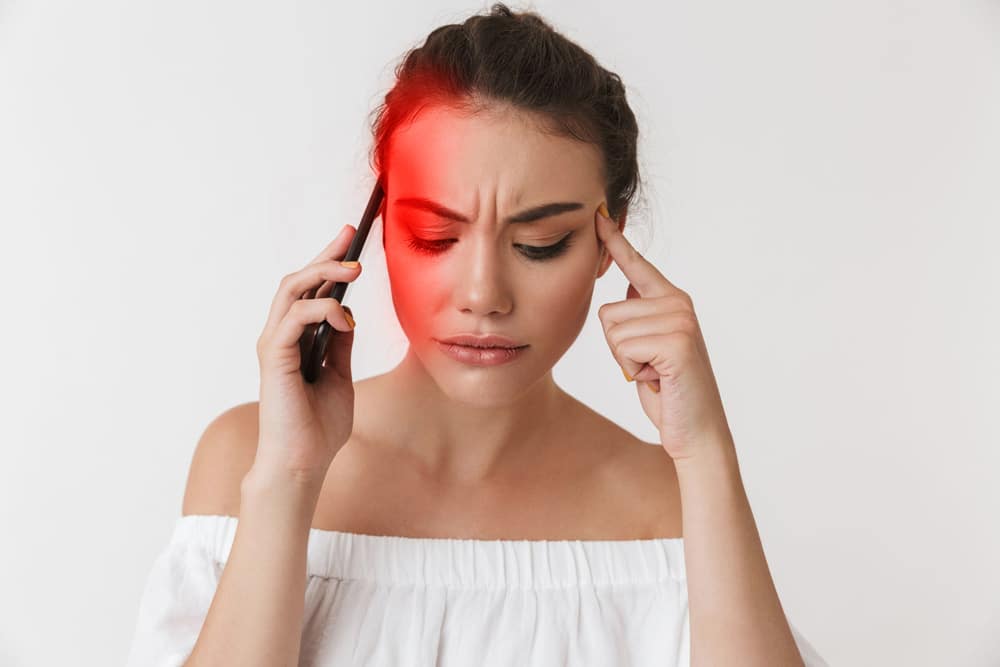
An April 2017 study found that in ten patients experiencing EHS symptoms, they all had consistent abnormalities in the same region of the brain. The brain had physical differences that were affecting and causing the symptoms in all ten of the patients.
There are enough people experiencing similar symptoms—symptoms that show up in EMF research—to show that it is a legitimate disease. Around the world, there are communities that bring together EHS sufferers. Community members found that living in normal society was too hard with their disease, so they have sought refuge where they can live a better and healthier life where they are not exposed to the EMF triggers.
EHS is a real condition, and considering MCS has been debated since the 1980s, and still isn’t fully accepted by the medical community, it seems it will take a long time for the medical community to recognize EMF hypersensitivity as well.

























